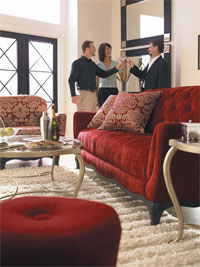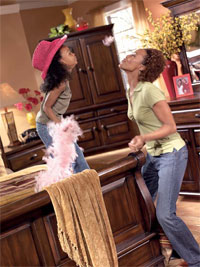Decorating without Fear
 Redecorating your home, or just one room, can be a daunting task. Many of us are plagued with unanswered questions from the outset: Where do I start? Am I making the right choice? Is this the right color to pick? These questions can leave us full of self-doubt, indecision and fear. These simple guidelines are intended to help you decorate your home without fear and self-doubt, so you can live your life in a setting that improves your attitude, state of mind and over-all well-being.
Redecorating your home, or just one room, can be a daunting task. Many of us are plagued with unanswered questions from the outset: Where do I start? Am I making the right choice? Is this the right color to pick? These questions can leave us full of self-doubt, indecision and fear. These simple guidelines are intended to help you decorate your home without fear and self-doubt, so you can live your life in a setting that improves your attitude, state of mind and over-all well-being.
Start with a plan
Planning in advance can alleviate decorating anxiety and save you time and money in the process. Planning Checklist:
- Room Function
- Room Measurements
- Scale
- Style
- Color Scheme
Room Function
Before you begin, take some time to look at your lifestyle: How do you currently use the rooms you will be decorating: Sleeping? Eating? Relaxing? Working? Who in your family uses the room: Adults? Kids? Pets?
Next, consider how you would like to use the room: What functions would you like to add to the room? Would you like to be better-able to browse the Internet while you are watching TV in the family room? What about a quiet reading corner in the bedroom?
Just as important, consider how you would like the room to not be used. Does your living room catch all your kid's toys? Does your mail stack up on the hall table? This might be an indication that additional functions (or storage) should be added elsewhere in your home.
Room Measurements
The old advice "Measure twice, cut once" could be reworked for decorating to "Measure twice, buy once." The pros know - you should go to the store with your room measurements in-hand. This includes entry ways and hallways leading into the room, after all, what good is it if the sofa will technically fit the room's space if you can't get it through the door. This is especially true when shopping for your anchor pieces (the large, dominant furniture) in a room.
Whether you draw it out on paper, or use an online room plan application, understanding the layout of your room will better equip you to furnish it to best suit your needs. A room plan will also allow you to move furniture around to determine what will and what won't fit in the space.

One thing that professional interior designers know that the rest of us often forget is that furniture doesn't have to be up against a wall. If, for example, you have a large greatroom, putting a sofa against one wall and the TV on the wall opposite it, you don't have the optimal viewing position and you have a lot of wasted space in between. In this example, floating the sofa in the middle of the room would create an opportunity to include other pieces in the room, like a game table and chairs, further increasing the functionality of the room.
Scale
The high-ceiling environments of many retailers can be misleading. What looks like a reasonable scale on the floor of a showroom may be either too large or too small once it is placed in a home environment. The age of your home could have an impact on the scale of furniture you select as well. Older homes, with traditional eight-foot ceilings, would feel cramped when filled with a larger-scale canopy bed. Conversely, a newer home with soaring vaulted ceilings might feel bare with a pared-down, platform bed.
Style
Many home design experts recommend that you create an idea file. Whether you plan to do the design yourself or take advantage of a retailer's design services, it's a good idea to have a place to start. Start with magazines; cut out pictures of rooms that you like, whether it's an article or an ad. You can also look online, there are many sites dedicated to collecting and cataloging photos of interior designs.
If you know what you like, but don't know what to call it, you might try taking a style quiz. This can point you in a design direction and equip you with a vocabulary to communicate your needs when you go shopping. Are you formal or casual? Traditional or cutting-edge? This self knowledge can help you achieve a more satisfying design in the end.
Color Scheme
A color scheme usually consists of three to four colors to be used throughout the room, with one color more prominent and the other colors serving as accents. A pre-determined color scheme will lead to a more cohesive, polished look for your room.
Your idea file can provide inspiration for your color scheme as well, but it doesn't have to be the only source. If you have a piece of artwork, an accessory or a collection you plan to include in the room, then take your color cues from there. You can also draw your inspiration from a fabric that will be included in the room. Select the dominant color and accent colors from that pattern. Paint samples are another great resource for developing a color scheme; you can use the individual cards to create your own scheme or rely on the paint company's ready-made color schemes.
Shopping Take-Alongs
If you plan to keep some of your existing furniture, take the measurements of that piece with you when you shop. If there are loose pillows or spare fabric, throw a sample in a bag to take along to the store so you don't have to rely on your memory of the color. You might even want to take a quick picture of it to bring with you as a reference as you shop.
Professional Advice
Find a retailer you trust, one that has been around for a long time and one that you know will be there tomorrow. You will often find more personalized service at family-owned, locally-operated retailers, rather than nation-wide chains. Many offer in-house design services and are willing to work with you to create a satisfying interior design.
 Redecorating your home, or just one room, can be a daunting task. Many of us are plagued with unanswered questions from the outset: Where do I start? Am I making the right choice? Is this the right color to pick? These questions can leave us full of self-doubt, indecision and fear. These simple guidelines are intended to help you decorate your home without fear and self-doubt, so you can live your life in a setting that improves your attitude, state of mind and over-all well-being.
Redecorating your home, or just one room, can be a daunting task. Many of us are plagued with unanswered questions from the outset: Where do I start? Am I making the right choice? Is this the right color to pick? These questions can leave us full of self-doubt, indecision and fear. These simple guidelines are intended to help you decorate your home without fear and self-doubt, so you can live your life in a setting that improves your attitude, state of mind and over-all well-being.
 One thing that professional interior designers know that the rest of us often forget is that furniture doesn't have to be up against a wall. If, for example, you have a large greatroom, putting a sofa against one wall and the TV on the wall opposite it, you don't have the optimal viewing position and you have a lot of wasted space in between. In this example, floating the sofa in the middle of the room would create an opportunity to include other pieces in the room, like a game table and chairs, further increasing the functionality of the room.
One thing that professional interior designers know that the rest of us often forget is that furniture doesn't have to be up against a wall. If, for example, you have a large greatroom, putting a sofa against one wall and the TV on the wall opposite it, you don't have the optimal viewing position and you have a lot of wasted space in between. In this example, floating the sofa in the middle of the room would create an opportunity to include other pieces in the room, like a game table and chairs, further increasing the functionality of the room.